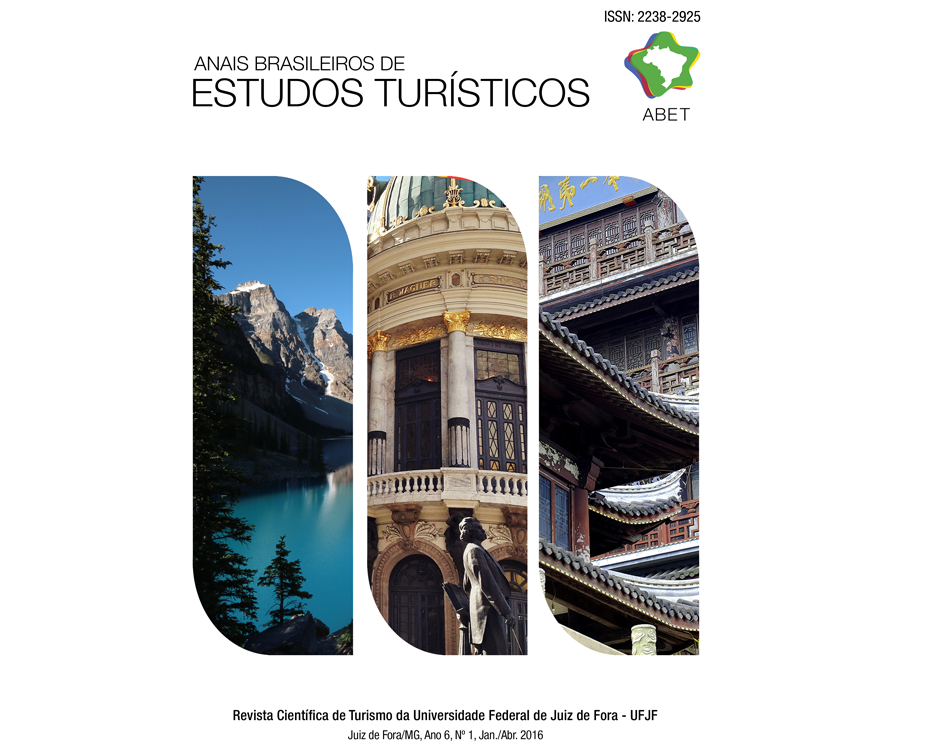The Sustainability of Commercial Tour Operations in Protected Natural Areas: defining categories of environmental supply
Keywords:
Environmental supply, Commercial tour operators, Sustainability, IndicatorsAbstract
There is a need in federally protected areas, such as national parks, to investigate the connection between management actions and responsible and sustainable tourism. Environmental supply, as a subset of ecosystem services, is a recent concept that seeks to contribute positively to park management actions about commercial visitor activities and environmental conservation in protected national areas. This can be accomplished by linking commercial visitor demand with understanding of tour operator’s views about environmental supply. This study targets commercial tour operator’s categorization of environmental supply in the Canadian Rocky Mountain national parks of Banff and Jasper.
As a concept, environmental supply includes natural features, physical attributes, management initiatives and/or governance policies that influence environmental conservation. Environmental supply, therefore, will include the ecosystems and services of the park destination, visitor education and interpretive programs, zoning and access, environmental impact assessment (EIA) procedures, policies and guidelines, and any other characteristics and initiatives that impact the conservation and/or preservation of nature at a visitor-centered site. How commercial tour operators respond to and manage these for environmental protection in a conservation environment will determine tourism sustainability at the destination.
This research presents the results of interviews and a pilot survey that provided information to create initial categories of quality success of environmental supply as defined by commercial tour operators in Banff and Jasper National Parks in the Rocky Mountains of Canada. The goal of this research is to provide a methodology to monitor changes over time by using categories of this research to define quality success indicators of environmental supply that are also parameters of sustainability in high use national parks.
Downloads
References
Broson, J. & Noble, B. (2006). Measuring the effectiveness of Parks Canada’s environmental management system. The Canadian Geographer, 50, 1, 101-113.
Buckley, R. (2000). Tourism in the most fragile environments. Tourism Recreation Research, 25, 31-40.
Hall, C. M. (1998). Historical antecedents of sustainable development and ecotourism: New labels on old bottles? In C. M. Hall & A. A. Lew (Eds.), 13-24. Sustainable tourism, a geographical perspective, New York, Addison Wesley Longman Limited.
Honey, M. (1999). Ecotourism and sustainable development, who owns paradise? Washington, D.C., Island Press.
Jamal, T. & Dredge, D. (2011). Editorial, certification and indicators. Tourism Recreation Research, 36, 3, 1.
Manning, R.E. (2001). Visitor experience and resource protection: A framework for managing the carrying capacity for national parks. Journal of Park and Recreation Administration, 19, 1, 93-108.
McCool, S. F., Moisey, R. N., & Nickerson, N. P. (2001). What should tourism sustain? The disconnect with Industry perceptions of useful indicators. Journal of Travel Research, 40, 2,
124-131.
McNicol, B. (2015a). The concept of environmental supply in national parks. In S. McCool & K., Bosak (Eds.), 183-199. Reframing Sustainable Tourism, Environmental Challenges and Solutions Series Volume 2, New York & London, Springer.
McNicol, B. (2015b). Environmental supply. In C. Carter, B. Garrod & T. Low (Eds.), 210, The encyclopaedia of sustainable tourism. Wallingford, CABI.
Manning, R. E. (1999). Studies in outdoor recreation: Search and research for satisfaction, second edition. Corvallis, OR, Oregon State University Press.
Mowforth, M. & Munt, I. (1998). Tourism and sustainability, new tourism in the Third World. New York & London, Routledge.
Parks Canada Agency (2010). Banff national park management plan. Banff, Alberta: Parks Canada Agency.
Parks Canada (2000). Managing human use - background paper for Minister’s Round Table. Banff, Alberta, Banff National Park.
Parks Canada (2001). Social science strategy framework. Banff, Alberta, Banff National Park.
Pavelka, J. & Rollins, R. (2009). Case Study: Banff and Bow valley. In Phillip Dearden & Rick Rollins (Eds.), 272-292. Parks and protected areas in Canada, planning and management, third edition. Oxford, Oxford University Press.
Ryan, C. (2003). Recreational tourism: Demands and impacts. North York, Ontario, Channel View Publications, Aspects of Tourism.
Torres-Delgado, A. & Saarinen, J. (2014). Using indicators to assess sustainable tourism development: A review. Tourism Geographies: An International Journal of Tourism Space, Place and Environment, 16, 1, 31-47.
Tisdell, C. & Wilson, C. (2012). Nature-based tourism and conservation, new economic insights and case studies. Cheltenham, U.K. & Northampton, MA, USA, Edward Elgar Publishing Limited.
Tribe J. (2008). Sustainability indicators for small tourism enterprises - an exploratory perspective. Journal of Sustainable Tourism 16, 5, 575-595.
White, L. & Noble, B.F. (2012). Strategic environmental assessment for sustainability: A review of a decade of academic research. Environmental Impact Assessment Review (Online).
Available: http://dx.doi.org/10.1016/j.eiar.2012.10.003.
Downloads
Published
How to Cite
Issue
Section
License
This journal provides immediate open access to its content, following the principle that providing free scientific knowledge to the public provides greater democratization of world knowledge.
Authors must agree to the following terms relating to copyrights:
(a) Authors keep all copyright and grant the to the journal the right of first publication, with the work simultaneously licensed under the Creative Commons Attribution License that allowing job sharing with recognition of authorship of the work and initial publication in this journal.
(b) Authors are allowed to assume additional contracts separately, for non-exclusive distribution of the version of the work published in this journal (e.g. publish in institutional repository or book chapter), with recognition of authorship and initial publication in this magazine.
(c) Authors are allowed and are encouraged to publish and distribute their work online (e.g. in institutional repositories or on your personal page) since they do not do this before or during the editorial process, as this can generate productive interchange, as well as increase the impact and citation of work aired. (See Effect of Free Access).















